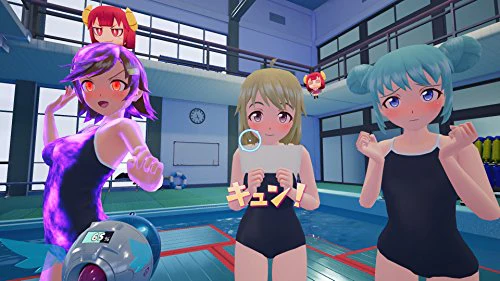
This article was originally published in Italian on GeekGamer.it in 2018.
Inti Creates, best known for creating Mega Man-inspired franchises, first launched the Gal Gun series on Xbox 360 as a scathing parody of the “ecchi” genre – that controversial category of manga and anime known for its titillating narratives, often criticized in the West for featuring female characters with exaggeratedly youthful features. While the original title remains exclusive to Japan, what began as an experimental game for an unpopular console has evolved into a full-fledged franchise spanning four installments, including a VR-exclusive version (surprisingly available on PlayStation VR in addition to other platforms).
Gal Gun 2 stays true to its predecessors, arriving on PlayStation 4 and Nintendo Switch with the series’ signature elements fully intact: beautiful girls, a school needing “exorcism,” and suggestive situations guaranteed to make even the most uninhibited otaku blush. But what about the actual gameplay?
At its core, Gal Gun 2 is an extremely basic on-rails shooter where traditional gun-toting enemies have been replaced by love-crazed schoolgirls determined to chase down the protagonist. Players find themselves armed with unusual equipment and thrust into colorful school-themed levels, sacrificing their virtual well-being to restore peace to what appears to be an all-girls institution (except for our hapless hero).
The protagonist suddenly finds himself entrusted with an enormous responsibility by none other than a fallen angel, who tasks him with purging the world of mischievous demons influencing the students at an unfortunate high school.
Our silent protagonist avatar, equipped with a “pheromone gun” and a special headset that makes him irresistible to women, must complete his mission while simultaneously navigating relationships with two female leads: the typical tomboyish childhood friend and a shut-in neighbor suffering from hikikomori syndrome.
From this disjointed setup emerges a game that, despite its premise, proves surprisingly lighthearted, with only occasional spikes of “suggestiveness” that never cross into explicit or vulgar territory. The narrative leans heavily into simple romantic comedy tropes filtered through the perspective of a teenager awakening to his sexuality, and while the characters are stereotypical, they remain believable and even enjoyable in their extreme simplicity.
The true heart of Gal Gun 2 lies in its gameplay: the Inti Creates title requires players to battle through levels filled with dozens of female students, each with on-screen “weak points” clearly marked. To stop their relentless advance toward the (un)lucky protagonist, players must rely on quick reflexes, precise aiming, and when necessary, use an “exorcism vacuum” to suck up the little demons that appear throughout levels. Of course, this vacuum might occasionally remove more than just demons – but where would the fun be otherwise?
That said, this latest effort from the Japanese developer performs respectably, with well-designed on-rails shooter levels enhanced by multiple path options. The game offers various challenge types including collectible hunts, levels requiring protection of groups of girls from demon attacks, and more traditional shooting segments. Naturally, there are also mini-games and sequences closer to traditional “ecchi” fare (which Gal Gun parodies so deliciously), but as mentioned, the game never crosses the line of decency. Of course, you’d be hard-pressed to play this game innocently on public transportation or in front of family members – but that’s part of the charm for this particular gaming niche.
If we were to highlight the most obvious flaw in a game like Gal Gun 2, we’d have to point to the extreme repetitiveness that permeates the long-term gameplay experience. While the game offers multiple endings and side quests (including an awkwardly sparse “dating mode” where players can ask out every girl in school – teachers included – each with unique backgrounds and personality-tailored dialogue), progressing requires endlessly repeating the same activities. Compounding this issue is a difficulty level that caters too heavily to beginners, neglecting more experienced shooter fans. And no, the “Time Attack” mode doesn’t provide sufficient incentive to replay levels.
From a technical standpoint, Gal Gun 2 maintains the aesthetic of its anime-inspired genre, and consequently doesn’t boast the most impressive polygonal complexity seen on current-gen consoles. The visuals embrace the classic “moe” style, following the conventions of sugary-sweet products that don’t deviate much from previous franchise entries. The PS4 version promises a locked 60 FPS (though occasional hiccups are noticeable), while the Nintendo Switch version runs at 30 FPS but makes good use of the hybrid console’s motion controls for aiming. In any case, the two versions are nearly indistinguishable, so if you’re undecided which to choose, simply pick based on your preferred control scheme.
All things considered, we can’t deliver a ruthlessly negative verdict on this Inti Creates title, as it exists within a gaming niche typically overflowing with far worse, far more exploitative titles that stage much more shameless scenarios than Gal Gun 2’s winking suggestiveness. Just prepare yourself for the high-pitched voices of maidens “thrilled” by your gunplay performance (pun absolutely intended).
Gal Gun 2 is ultimately a lighthearted, colorful on-rails shooter that’s neither vulgar nor offensive despite what more puritanical corners of the internet might claim. To conclude this generally positive review (despite the criticisms noted above), we should emphasize that this fourth series installment (despite the “2” in its title) seems to lack some of the personality and sharp parody that distinguished its predecessor (still available on PS4).


